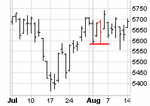firewalker99 said:
My first target is -or was- trying to understand why price moves in the way it does. I'm not sure if it's still worth pursuing in that way that perhaps I'm trying too hard at comprehending every move price makes. The second target was trying to base a strategy on the "acquired knowledge and ability to read the market". The third target was indeed to start making money, but not after I fully understood what was going on.
Now about my question on the two charts been talked about so much. I didn't say this was a situation I would build a plan or setup around. The only thing I was inquiring was why you stated "there is a relatively safe entry with a tight stop which you could make even if you didn't incorporate volume". For that reason only, I posted a similar chart where price did go against you. Let's put it this way: would you see any signals on the second chart (that would indicate this is not a relatively safe entry) that you could not distinguish on the first chart?
You asked why I made the statement and I explained why I made the statement. I then explained one way I would trade it
in real time, not in hindsight.
I don't care about why.
I don't care about predicting the future.
I don't care about the meaning of it all.
All that matters to me is whether the setup materializes or not. If it does, I know what to do. If it doesn't work out, I also know what to do. If it doesn't materialize at all, I do nothing.
Db
I've been asked repeatedly about the charts posted
earlier, and since newcomers continue to read this thread, it seems appropriate to revisit this issue so that my meaning with regard to realtime analysis vs hindsight analysis may be clearer.
As Justin Mamis has said, hindsight is not available as a tool. This is not to say that hindsight analyses are not impressive. They ought to be. Knowing the future always lends a certain confidence, and the hindsight analyst would have to be truly incompetent not to come off as extraordinarily perceptive.
But hindsight analysis can do no more than tell the trader what he should have done. There's no money to be made in chewing over what should have been done (though if one is still in the process of defining and testing a setup, hindsight analysis is not only necessary but unavoidable given that he is not yet trading). If one wants to make money, he has to act in real time. Thus all of the "analysis" regarding "fractured" volume, while possibly entertaining, is irrelevant to the task of making realtime trading decisions.
To make those decisions, one must act in real time. He must know what he's looking for, be able to recognize it in real time, and act upon what he knows and what he sees. If he waits until everything is wrapped and tied up with a ribbon and bow and there can be no doubt as to the proper course of action, it's nearly always too late.
Here it is to be hoped that the trader is stopped out fairly quickly, either by breaking the demand line (1) or by falling below the congestion level (2). Staying in all the way to a break of the last swing low is not practical for a daytrader, particular since he is trying to catch a reversal.
When price makes a new low, therefore (3), he again applies the Wyckoffian paradigm: selling climax, technical rally, test, upmove or failure. If the trader knows that the area around 5625/30 is serious support, he might make an aggressive entry. However, he can't know whether or not this is a selling climax
except in hindsight. So he waits for the test (4). This lower low is accompanied by lighter volume, suggesting that sellers are done or nearly so. Therefore, an entry here is not quite so aggressive. If he wants to be more conservative, however, he can wait after what may be a technical rally for the
higher low, which comes soon thereafter (5). If even this seems too risky, he can wait for the break of the technical rally's high (6). And, yes, this trade can still fail. But focusing on the setup -- i.e., the Wycoffian paradigm -- increases the probability of a successful trade. Thereafter, all he has to do is track the demand lines (a new one is drawn, if necessary, with each new high) and the highs and lows of each swing.
In real time.
It should also be noted that if the trader is so conservative that he squeaks, he can also wait for a break of the higher supply line (7). However, waiting for this much confirmation increases rather than decreases risk, and the probability that the move is losing momentum is greater.
Hindsight review will, of course, tell the trader that he applied his rules properly and acted correctly in real time. But the realtime trader will have profited from this move. The hindsight analyst who does nothing else will have nothing but couldawouldashoulda.
Db


